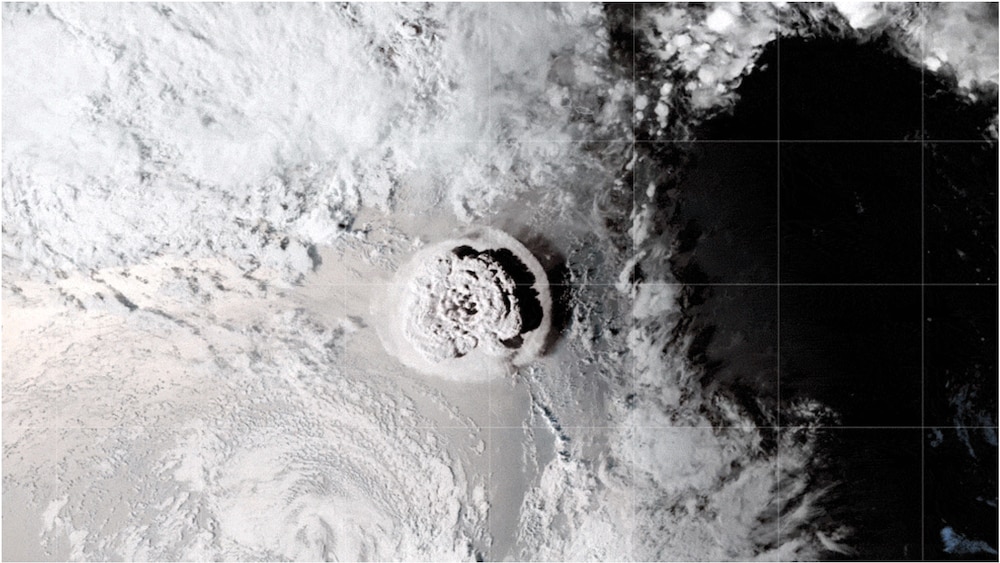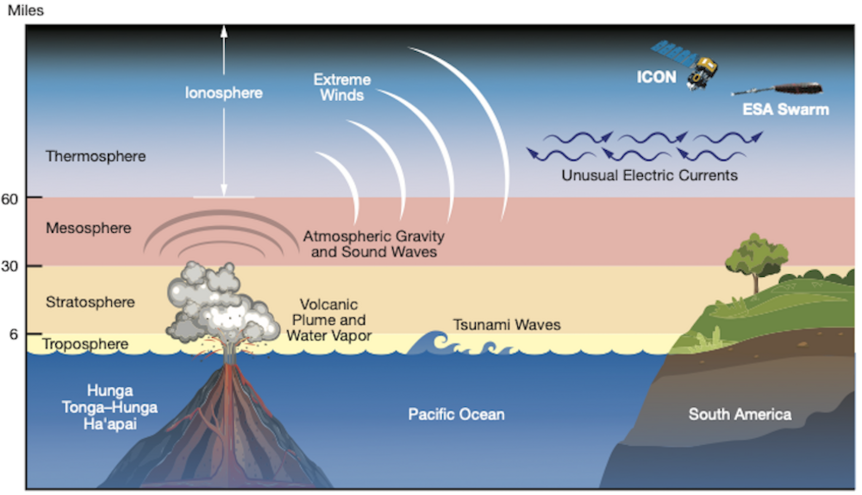Create a free profile to get unlimited access to exclusive videos, sweepstakes, and more!
Volcanic eruption was so extreme, it reached space
This gives new meaning to "out of this world."

Volcanoes that explode into plumes of magma and ash can be powerful enough to trigger huge shockwaves and sonic booms above while kicking up earthquakes, landslides, and tsunami waves closer to the surface. Now a volcano did all of the above and touched space.
These types of phenomena don’t just happen in movies like Dante’s Peak. The Hunga Tonga-Hunga Ha’apai volcano makes the killer eruption faced by Pierce Brosnan’s decidedly un-James-Bond-ish volcanologist look like hardly any more than a bonfire. It erupted so violently that not only did it rock the atmosphere and the ocean, but NASA found the effects reached further beyond Earth’s atmosphere, with winds fast enough to rival a hurricane right on the edge of space. It is now one of the most enormous disruptions ever observed in space.
Besides having a notoriously hot temper -- Hunga Tonga-Hunga Ha’apai's last eruption in 2015 spewed ash over five miles into the sky and actually formed a new island from all that vomitus -- the underwater volcano has now given researchers the chance to see what happens when Earth weather and space weather collide. Physicist Brian Harding of UC Berkeley led a study on the fire-breathing monster, recently published in Geophysical Research Letters.
"The volcano can teach us which kinds of atmospheric waves transfer momentum and energy from the ground to space," he told SYFY WIRE. "We hope this represents the mechanisms that transmit momentum and energy from the lower atmosphere to space, and will eventually lead to better predictions of space weather."
Hunga Tonga-Hunga Ha’apai lurks in the depths of the western South Pacific Ocean, off the coast of Tonga’s main islands. Some of the tsunami waves in its wake were high enough to reach the stratosphere, and the dust and gas it belched out broke through into the Mesosphere. NASA’s ICON (Ionospheric Connection Explorer) and ESA’s Swarm satellites were in on the action. Just hours after the active volcano exploded again, both spacecraft picked up on strange electric currents in the uppermost layer of the atmosphere, or the ionosphere.
Understanding phenomena like this is (for the most part) only possible through observations. You just can't recreate something like this in a lab. Even making sense of observations can be difficult when multiple processes are all going on at the same time and place, which can confuse cause and effect.
ICON has its eye on the edge of space. It observes a region where gases can be turbulent and gusts of solar wind bring charged particles sweeping through. When solar flares and coronal mass ejections happen, onslaughts of these particles can bring on geomagnetic storms that mess with our satellites, internet, and electrical infrastructure.The Hunga Tonga-Hunga Ha’apai eruption was capable of something that only a geomagnetic storm was thought to do.
Intense winds affect electric currents in the ionosphere, which explains why ICON and Swarm detected something suspicious. Ionospheric particles, mostly electrons and ions like NO+ and O2+, create a current known as the equatorial electrojet.
"It's not the electrical currents themselves that are the most severe impacts of space weather, but rather, the electric currents are an unambiguous marker of modifications of the ionospheric dynamo system," Harding said. "This has further implications on the distribution of plasma."
As winds from the lower atmosphere propel the electrojet, it flows east. Plasma that is disrupted can cause electricity, communications, and navigation systems (such as GPS) on Earth to malfunction. This eruption disturbed the electrojet so much that it temporarily became five times more powerful than usual. It also experienced a phenomenon that nothing except a powerful geomagnetic storm has ever caused: The flow of the electrojet was actually turned around.
It isn’t that much of a shock to scientists when a reversal like this happens, since the Sun is always having some sort of tantrum that sends charged particles rushing in and sometimes flipping around the electrojet if they have enough influence. The Hunga Tonga-Hunga Ha’apai eruption was also the strongest reversal that Swarm has ever seen, and ICON just happened to have the right timing and positioning to catch it. What ICON beamed back to terra firma showed that there was extreme turbulence in the ionosphere. Its observations were close to previous predictions of how the upper atmosphere would be affected by a disturbance of this magnitude.
"Before we can hope to predict the upper atmospheric response to the myriad sources of variability coming from below, we have to first be able to predict the upper atmospheric response to a simple source like the explosion," said Harding.
What happens where the atmosphere ends and space begins is just starting to be understood. After upcoming NASA mission GDC (Geospace Dynamics Constellation) launches in 2027, it will watch for more events where the furthest reaches of Earth end and the final frontier begins.



























